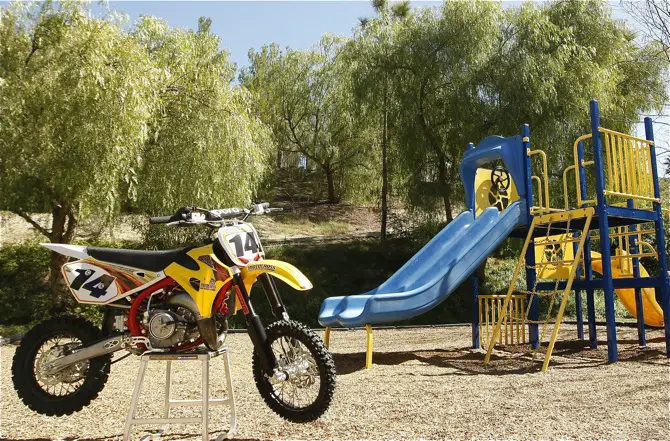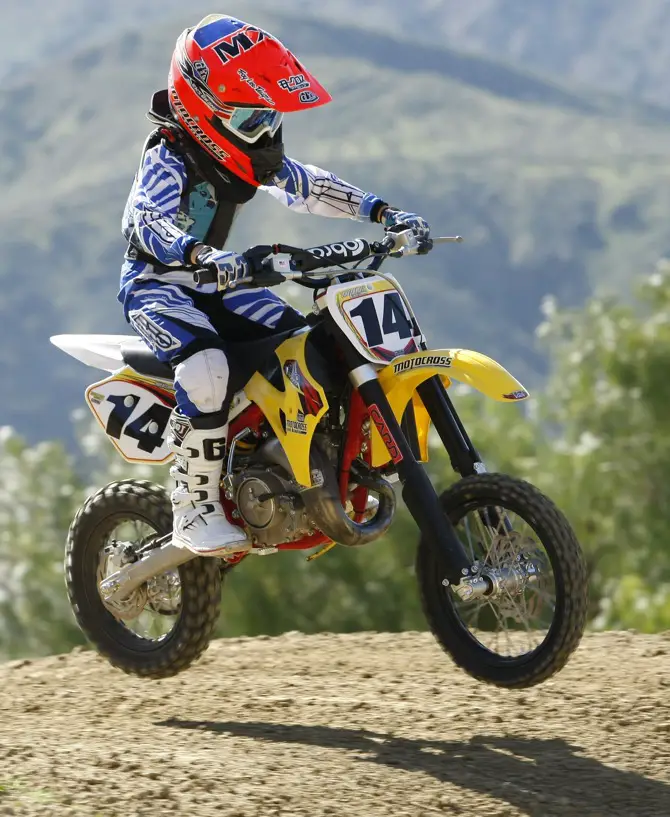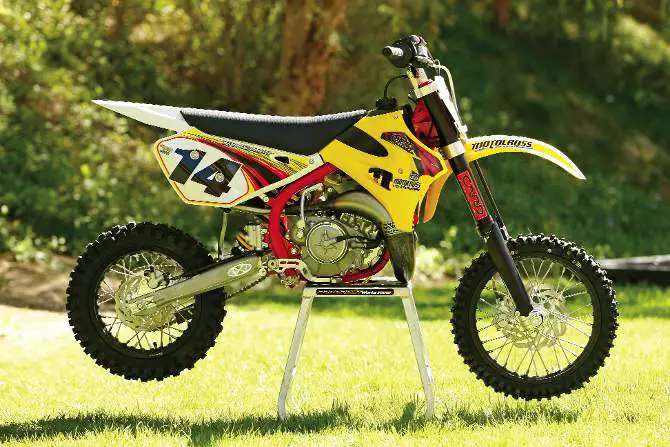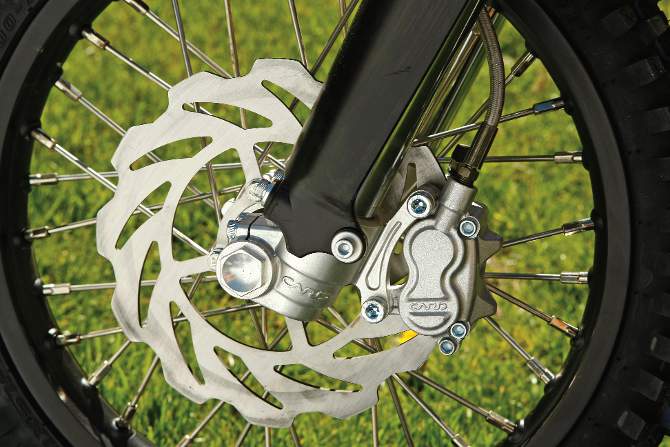MXA’S 2014 COBRA CX65 MOTOCROSS TEST: THE DOMINANT PEE-WEE BUILDER STEPS UP TO THE 65 CLASS IN A BIG WAY

FIRST AND FOREMOST, WHY IS MXA TESTING A MINICYCLE?
A: Why wouldn’t we? While it’s true that the major manufacturers’ minicycles have changed so little over the last 10 years that they don’t deserve to be tested, that doesn’t apply to a progressive manufacturer like Cobra. American-owned Cobra has been in business for 20 years and made a name for itself in the 50cc market. Recently, they have ramped up their efforts in the 65cc class.
On paper, the Cobra CX65 is incredible. It is loaded with aftermarket hop-up parts, yet it is sold as a stock bike (more on that below). The CX65 was built specifically for race-driven 6- to 11-year-olds who want to challenge for wins. It is not a recreational bike for Junior to tinker around on; it is a motocross bike, plain and simple. Since MXA is the leader in bike tests, we thought it would be beneficial to put the 2013 Cobra CX65 through the wringer.

Q: WHAT IS THE HISTORY OF COBRA MOTORCYCLES?
A: Cobra was started because a father saw an opportunity to satisfy a need that wasn’t being met. When his son was racing in the 50cc Peewee class, Cobra founder Bud Maimone was looking for a race-ready bike for his son to compete on. Frustrated that there weren’t any, Maimone decided to design and build his own bike, and so Cobra Motorcycles was born.
Would you be surprised to learn that several big-name stars made their mark on a Cobra? It’s true. Davi Millsaps was Cobra’s first champion to make it big in the Pro ranks. Eli Tomac, Blake Baggett, Broc Tickle, Nico Izzi and others have followed suit. Even more amazing is that since 1994, the first year that Cobra entered the Amateur Nationals, the U.S. manufacturer has only lost one 50cc class title to another brand.
In 2003, Sean Hilbert became the CEO of Cobra. Hilbert notes, “Since the current management team took over, we have increased bike sales a little bit. The heyday of motorcycle sales of the late 1990s and early 2000s is gone, but we still manage to grow the company, and we’ve added international distribution. We’re selling bikes to Europe, Latin America and Japan. Cobra is making an American motocross bike, and that means a lot to us.”
Besides increasing sales, the new leadership at Cobra is paying attention to the market and developing bikes that meet its customer needs, which is why we are testing the Cobra CX65. Truth be told, the Youngstown, Ohio, company has been building and refining their 65cc two-stroke for many years. Sean Hilbert adds, “There was a 65 in development when we took over the company. We realized that it wasn’t the bike it needed to be. We ended up scrapping the whole design and starting over. The CX65 was launched with limited success in 2010, but we stepped up our program in 2012. The newest-generation CX65 has an electronic power valve and beefed-up suspension. It has a world-class engine, chassis and suspension package.”

Q: WHAT ARE THE DEFINING CHARACTERISTICS OF THE 2013 COBRA CX65?
A: Unlike the full-size four-stroke market, where cutting-edge technology is standard, the minicycle category is way behind. Cobra intends to change that. Below is a breakdown of the CX65.
(1) Engine. The Cobra CX65 is the only bike in the 65 class with a direct-acting, electronic power valve. It is designed to open up at 8500 rpm and takes 30 milliseconds to go from being fully closed to fully open. The power valve provides consistent power and eliminates valve flutter on the starting line.
It’s very interesting that Cobra uses a patent-pending, two-piece cylinder design. Hilbert elaborates: “The two-stroke cylinder porting business has managed to stay afloat over the years because porting guys make sure that the timing of the ports is perfect from one side to the other. We are CNC-machining our port surfaces. We innovated it in the U.S. to rapidly develop port designs, but it worked so well that we figured we would put it into production.”
A guillotine power-valve design seals off the piston when closed and provides for a smooth exhaust-port roof when open. This improves bottom-end torque and top-end power. The crankcase is water-cooled for a more consistent engine operating temperature over the course of a long moto. A Pro Circuit Works pipe and Shorty R-304 silencer complement the engine package, as does the Moto Tassinari VForce 3 reed block.
(2) Transmission. Your child better learn how to shift manually if he wants to ride a Cobra CX65. The bike has a six-speed gearbox (one down and five up). The hydraulic clutch is a nice touch, as is the quick-change clutch cover that provides easy access to the clutch. The clutch itself is expandable and accepts an extra drive and friction plate to handle the load if you decide to modify the CX engine for more power.
(3) Suspension. Cobra has developed the MXT “Smart Leg” front fork. The “Smart” technology provides supple action over small bumps and progressive control in the case of larger impacts. Rebound and compression adjustment clickers are located on the left fork leg, while the right fork handles bottoming adjustments. Additionally, the 37mm stanchion tubes use super-high-quality SKF fork seals and have 220mm of travel. The CARD (Cobra Advanced Racing Development) piggyback rear shock has adjustable rebound, as well as high- and low-speed compression adjustments. The non-link shock has 270mm of travel.
(4) Chassis. Cobra designed the twin-spar steel frame with their own proprietary oval tubing. The goal was to find a material that would be very stiff laterally but offer torsional flexibility. Why? The frame had to give when being ridden through ruts but remain strong enough to handle jump landings.
The X-Track swingarm is an engineering marvel. The side arms are crafted from a 359 T-6 aluminum material that Boeing developed for their landing craft. The swingarm is bonded with the same kind of adhesive that is used on fighter jets. This process allows for very accurate control over dimensions during development and saves weight. Cobra claims that the CX65 swingarm is the lightest in its class by nearly a pound. The subframe is aluminum.
(5) Brakes. The Cobra CX65 boasts the biggest front-brake rotor in the class. At 205mm, it takes up nearly half the circumference of the rim. It takes a four-piston caliper and steel-braided line to handle the massive rotor. The front brake lever can be adjusted outward or closer to the handlebars (a la KTM) for a customized position. Cobra also incorporated a dial that can change the amount of freeplay between the caliper and the lever. The front brake can be set up to stop on a dime or have more modulation.
The rear brake uses a 165mm wave-style rotor. A large pedal makes it easy for young riders to find the rear brake.

2013 Cobra CX65: Believe it or not, at $4748 the Cobra CX65 isn’t the most expensive Junior Cycle on the market.
(6) Wheels. The CX65’s wheels are built to sustain tremendous impacts. The black-anodized aluminum rims (14-inch front and 12-inch rear); billet aluminum hubs; and nine-gauge, stainless-steel spokes are very durable.
(7) Airbox. With the largest airbox in its class, the CX65 air filter has a sizable surface area, which means better airflow and more power, even under the worst conditions. Removing the air filter is a breeze. Simply remove the seat with a 5mm Allen wrench and unhook the air-filter wire from its perch.

Q: IS ANY OTHER MINIBIKE ABLE TO COMPETE WITH THE COBRA CX65?
A: Although there are several manufacturers producing 65cc two-strokes for racing, the Cobra CX65 really only has one worthy challenger: the KTM 65SXS. Coincidentally, KTM unveiled the special-edition 65SX in 2012, the same year Cobra introduced their electronic power valve engine.
Sold in limited numbers, the 2013 KTM 65SXS has WP suspension, a performance cylinder and carburetor settings, an FMF pipe and silencer, billet parts (ignition cover, chain guide, case guard and chain blocks), a holeshot device, an orange Renthal rear sprocket, and special graphics.
Both the 65SXS and Cobra CX65 come with a hydraulic clutch, quick-change clutch cover, six-speed manual transmission, four-piston front-brake caliper, oversized front rotor, aluminum subframe, large footpegs, an aftermarket exhaust and progressive-rate shock.

Better living: Armed with an electronic power valve, Moto Tassinari reed block and Pro Circuit pipe, the CX65 is race-ready.
Q: CAN THE 2013 COBRA CX65 BE RACED IN THE STOCK CLASS?
A: Yes. It is fully legal for AMA Amateur motocross competition in the stock class. The rule book states, “To be eligible for a stock class, the following cannot be changed or modified: Internal engine components, electronics, frame, carburetor, air box, swingarm, rim size, wheel hubs and exhaust system.”
Despite being littered with aftermarket trinkets and purpose-built items designed to improve quality and performance, the 2013 Cobra CX65 still qualifies as stock. The CX65 comes out of the crate with a Pro Circuit exhaust, Moto Tassinari VForce 3 reed block, electronic power valve, incredibly light aluminum swingarm and much more. These hop-ups alone are a huge selling point for the Cobra, but the fact that it can be raced in the stock class makes it extra enticing.

Q: HOW MUCH DOES THE COBRA CX65 COST?
A: $4748. To compare, the 2013 KTM 65SX retails for $4499. The fully modified KTM 65SXS sells for $5299, while the 2013 Kawasaki KX65 retails for $3649. That is a wide range of prices. The KTM 65SXS is the cream of the Austrian crop. It is in direct competition with the Cobra CX65, but costs a little bit more. Why is the KX65 over $1000 cheaper? It is antiquated compared to the Cobra and KTM offerings due to years of neglect. The KX65 was a competitive machine?a long time ago (before KTM and Cobra ramped up their efforts).

Flight: The step up from a 50cc Peewee to a six-speed Cobra CX65 means that Junior has to master the skills of using the clutch and shifting.
Q: HOW FAST IS THE 2013 COBRA CX65?
A: Fast is a loaded word. For concerned parents afraid for little Johnny’s safety, fast probably has a negative connotation. Make no mistake about it?the Cobra CX65 is powerful. It should be. Cobra didn’t leave any stone unturned?punching up the powerband with engine work, an aftermarket exhaust, reed block, and finely tuning the two-piece cylinder. Every test rider agreed that the CX65 ran like a scalded cat. The powerplant was the testers’ favorite attribute of the bike. The engine has bottom-end hit and solid pull through the range. Power really spikes once the electronic power valve opens, and it surges into the top end. The stock 14/45-tooth gearing combination is sufficient for most tracks, although we would probably add a tooth to the rear sprocket on tighter tracks or for less-experienced riders.
Q: WHAT EXACTLY IS “CARD”?
A: “CARD” is an acronym for Cobra Advanced Racing Development. Cobra develops their own line of motorcycles, but they also sell aftermarket components for their bikes. The CX65 comes with a CARD fork, shock, front brake system and clutch master cylinder. Cobra also offers radiator hoses, billet gas caps, aluminum ignition covers and anodized oil-fill plugs. Expect Cobra to offer more CARD accessories in the future.
A growing number of aftermarket companies are investing research and development dollars in products for Cobra bikes. Dennis Stapleton Sr., of Knobby Shop South in Murrieta, California, is one example. He is selling skid plates, seat covers and bolt kits for Cobra bikes. More products will be available in the coming months. Contact Stapleton at (831) 818-5910.
Q: HOW DOES THE COBRA CX65 HANDLE?
A: The CX65 chassis is very balanced front to rear. Although the gas tank is quite wide, most 65 riders don’t move too far forward on the bike. Instead, they are positioned directly over the footpegs. That’s not necessarily a bad thing. The steel chassis is very forgiving in corners, and riders were very impressed with the CX65’s handling characteristics. Of course, the CARD suspension is a big factor, and testers were pleased with the forks and shock. Often, a sharp-handling bike sacrifices stability at speed, but that isn’t the case with the Cobra. It is a jack of all trades, giving up very little across a wide range of situations. Most important, the Cobra CX65 is confidence-inspiring, an especially critical quality in a bike designed for a mini rider.

Technology: Cobra’s MXT Smart Leg technology gives the CX65 a leg up in the fork department. The 37mm fork uses high-quality SKF fork seals and offers 220mm of travel.
Q: WHAT DO WE THINK ABOUT THE SUSPENSION?
A: It’s hard to believe what Cobra has done with the CX65 suspension. Years ago, we never could have imagined that a 65cc two-stroke would come equipped with beefy, 37mm, upside-down forks with the capacity to control bottoming resistance. Just by the looks of them, the MXT Smart Leg forks are an engineering marvel; on the track, they were just as impressive. The no-nonsense shock was easily adjustable, and only minor changes were required to accommodate our young test riders. The 65cc class covers a wide range of skill levels, weights and ages, and most kids have no idea what they want when it comes to fine-tuning their suspension. Cobra gives parents a wide range of shock and fork options so that they can experiment to find the right settings.
Q: HOW COULD THE COBRA CX65 BE IMPROVED?
A: It’s hard to criticize anything on this highly tuned, purpose-built bike, but our mini testers did have a few minor complaints.
(1) Front brake. Although the CX65 front brake uses a four-piston caliper, steel-braided line and huge 205mm rotor, it wasn’t quite as user-friendly as the KTM 65SX’s system. We appreciated that the Cobra brake system had various setup options, but the feel at the lever wasn’t as good as on the KTM.
(2) Clutch. We didn’t have any issues with the clutch system, other than the lever pull. Smaller, weaker riders tired out easily after pulling in the clutch lever repeatedly over a long moto (and trust us when we say that most kids love to ride for hours on end).
Q: WHAT DO WE HATE?
A: The hate list:
(1) Rear brake pedal. The rear brake pedal is over-designed and under-engineered. It is flimsy, and the arm is too large. Be sure to run a brake snake.
(2) Front brake. We love everything about the front brake, except that it doesn’t quite have the modulated feel that testers were looking for. Plus, the caliper is about 2mm away from the front spokes.
(3) Gas tank. The tank is wide, making it challenging for taller riders to move forward on the bike.

Pucker up: Cobra can boast about having the largest front brake rotor in the class. At 205mm it offers tremendous power without the need for massive hand strength.
Q: WHAT DO WE LIKE?
A: The like list:
(1) Engine. The CX65 powerplant is a rip-roaring machine, built for racing and ready to win. The two-piece cylinder is especially cool.
(2) Suspension. The CARD forks and shock did an excellent job of soaking up small chop while also handling hard landings.
(3) Power valve. A first in the 65 class, the electronic power valve boosts power from the midrange to the top end.
(4) USA-made. Cobra is the only producer of offroad motorcycles that is made in the U.S. Very cool.
(5) Stock class. Believe it or not, the CX65?chock-full of aftermarket parts?can be raced in the stock class.
Q: WHAT DO WE REALLY THINK?
A: Imagine a motorcycle that is ready to race right out of the crate, at the highest level, and requires very little investment beyond the initial purchase price. The bike can legally compete in the stock class, has won numerous championships under the fastest youngsters in the sport, and is made in America. The Cobra CX65 is a winner, through and through.





Comments are closed.